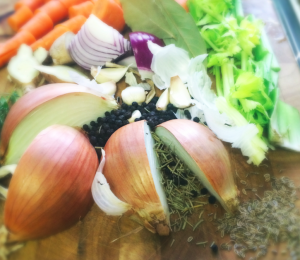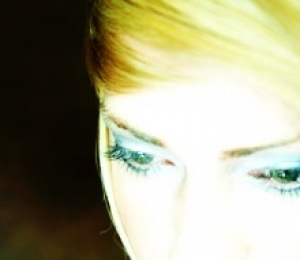Your home is your haven and it should support your health. Perhaps check your cupboards and read the labels of your cleaning products. Do you see Ammonia, Methylene chloride, Naphthalene, Silica, Toluene, Xylene, Phosphates or 2-butoxyethanol/Ethylene glycol? These are all highly toxic chemicals that do not support an optimum living environment. Toss out and replace them with eco-friendly and body-adoring cleaning supplies such as:
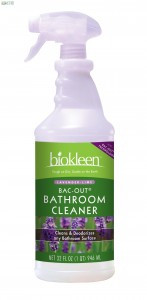 BioKleen Lavender-Lime Bac-Out Bathroom Cleaner
BioKleen Lavender-Lime Bac-Out Bathroom Cleaner
If you really think about it, there is an exorbitant amount of bacteria lurking in your bathroom sink, shower, toilet and floor. Give surfaces a deep detox without the use of harsh chemicals. I like BioKleen’s Bac-Out Bathroom Spray. It gets the job done without leaving disease promoting toxins behind.
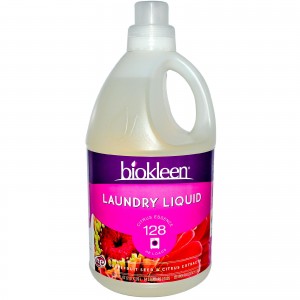 BioKleen Citrus Laundry Detergent
BioKleen Citrus Laundry Detergent
Many laundry detergents on the market contain chemicals that promote allergies, a weakened immune system, and neurological disorders––a pretty severe lineup of consequences just for washing clothes. I’ve opted to use an eco-friendly detergent made by BioKleen. Their lavender scented wash is my favorite.
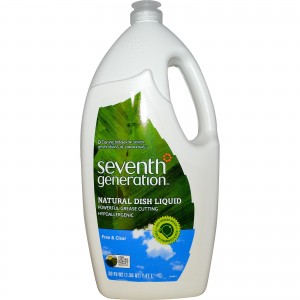 Seventh Generation Dish Soap
Seventh Generation Dish Soap
I feel like doing the dishes takes up half my day. Fortunately there are a number of non-toxic dish soaps on the market to wash with. If I’m going to be at the sink scrubbing away, at least I don’t have to absorb chemicals through the palms of my hands. I prefer Seventh Generation brand as it is affordable and their scents are fresh and clean.
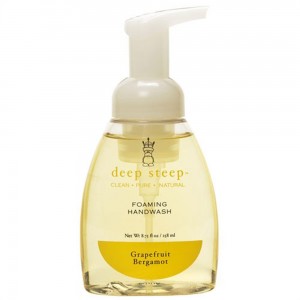 Deep Steep Foaming Hand Wash
Deep Steep Foaming Hand Wash
I keep a bottle of Deep Steep foaming hand wash at every sink in my house. When one runs out I rotate in another scent like their bergemont-grapefruit, rosemary-mint, brown sugar & vanilla, or honeydew-spearmint.
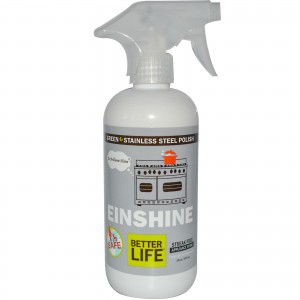 Einshine Stainless Steel Polish––Lavender and Chamomile
Einshine Stainless Steel Polish––Lavender and Chamomile
If you have stainless appliances, you know keeping them fingerprint free can be challenging. I’ve discovered this non-toxic polish that smells fresh and keeps finishes shiny and bright.
Below is a list of harmful ingredients in household cleaning products – Shared from PureZing.com
Ammonia
Irritation to eyes and mucous membranes. Breathing difficulty, wheezing, chest pains, pulmonary edema, skin burns. High exposure can lead to blindness, lung damage, heart attack or death.
2-butoxyethanol/ Ethylene glycol butyl ether
One of many glycol ethers used as a solvent in carpet cleaners and specialty cleaners. Can be inhaled or absorbed through the skin and may cause blood disorders, as well as liver and kidney damage. May also cause reproductive damage with long-term exposure. 1,4 dichlorobenzene (1,4 DCB) Has been linked to a reduction in pulmonary function. Found in space deodorizing products, such as room fresheners, urinal cakes, toilet bowl fresheners and cleaning products it is also used as an insecticide for moth control.
Ethoxylated nonyl phenols (NPEs)
Known as “gender-benders,” nonyl phenols can induce female characteristics in male fish, for example. The threat posed to the environment by nonyl phenols prompted the European Union to ban them from all cleaning products manufactured or used in the EU. Still used in the U.S.
Methylene chloride
Methylene chloride is listed as a possible human carcinogen by the International Agency for Research on Cancer and is commonly found in paint strippers. In 1987, regulators in the U.S. compelled manufacturers to put warning labels on products containing methylene chloride.
Naphthalene
Either naphthalene, or another chemical called paradichlorobenzene, is used in mothballs and moth crystals. Naphthalene is listed by California’s Office of Environmental Health Hazards Assessment as a substance “know to the state to cause cancer,” while paradichlorobenzene is listed by IARC as a possible human carcinogen. Avoid all moth products that contain either of these two ingredients.
Silica
Made from finely ground quartz, silica is carcinogenic as a fine respirable dust. Silica is found in that form in some abrasive cleansers, which are often used on a regular basis around the home.
Toluene
Toluene is a potent reproductive toxin, which is used as a solvent in numerous products, including paints. It is also sold as the pure product and is listed by California’s Office of Environmental Health Hazard Assessment as a reproductive toxin that may cause harm to the developing fetus. Pregnant women should avoid products containing toluene.
Trisodium nitrilotriacetate (NTA)
NTA is listed as a possible human carcinogen by the International Agency for Research on Cancer. It is used as a builder in laundry detergents and also has an adverse environmental impact as it can impede the elimination of metals in wastewater treatment plants. NTA’s action can cause metals that have already settled out to be re-mobilized back into the liquid waste stream.
Xylene
Another extremely toxic ingredient that is often found in graffiti and scuff removers, spray paints and some adhesives. A suspected reproductive toxin that has shown reproductive harm in laboratory experiments, it is also a neurotoxicant that can cause memory loss on repeated exposure.
Bleach (Sodium hypochlorite)
When bleach is mixed with acids (typically found in toilet bowl cleaners), it reacts with them to form chlorine gas. When it is mixed with ammonia, it can create chloramine gas, another toxic substance.
In the environment, sodium hypochlorite is acutely toxic to fish. The chlorine in bleach can also bind with organic material in the marine environment to form organochlorines, toxic compounds that can persist in the environment.
There may be some circumstances where bleach use is necessary for disease control, but there is little need for it on a regular basis. Tests have shown that washing counters and other surfaces with soap and water removes most bacteria and there are a number of oxygen-based alternatives for laundry uses of bleach.
Phosphates
Manufacturers have since reduced or even eliminated phosphates from laundry products, but no action has ever been taken on dishwasher detergents. Most of the products available from major manufacturers contain 30-40 per cent phosphates. Some also contain high levels of chlorine-based sanitizing ingredients.
Featured Image Photo Credit: Green-Coop.com




